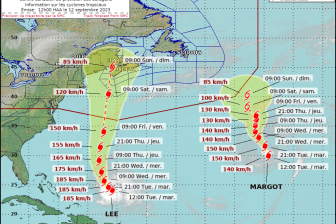
Higher interest rates are putting Canadians off borrowing, Statistics Canada said Wednesday, while boosts in income are helping to offset higher debt-servicing costs.
Statistics Canada says there was $1.81 in credit market debt for every dollar of household disposable income in the second quarter, down from $1.84 in the first three months of 2023.
Household credit market debt as a proportion of household disposable income, on a seasonally adjusted basis, fell to 180.5 per cent in the second quarter compared with 184.2 per cent in the first quarter of the year.
Meanwhile, the household debt service ratio, measured as total obligated payments of principal and interest on credit market debt as a proportion of household disposable income, was 14.79 per cent in the most recent quarter, down from 14.90 per cent in the first quarter, when it hit its highest point since 2019.
StatCan said household disposable income was up 2.6 per cent in the second quarter, helping to drive down the impact of higher debt obligations tied to the Bank of Canada’s rapid interest rate hikes since March 2022.

Seasonally adjusted household credit market borrowing fell to $17.1 billion in the second quarter compared with $20.4 billion in the first quarter as demand for mortgage loans fell to its lowest point since 2005.
TD Bank economist Maria Solovieva said in a note to clients on Wednesday that these declining figures, alongside growing household wealth and rebounding real estate valuations, “brings some good news about the state of Canadian households through the first half of the year.”
However, she cautioned that the aggregate improvements in debt-to-disposable income ratios “mask the pain felt by some Canadian households.”
Gains in income came as Canadians were still facing elevated levels of inflation in the second quarter of the year, she noted, adding that the latest figures from Equifax Canada show rising delinquency rates on many credit products.
StatCan, too, noted that earnings gains are not equal across income brackets, leaving some Canadians more vulnerable to higher debt obligations than others.
“The Bank of Canada will need to maintain a close watch on household credit performance as higher interest rates continue to weigh on Canadian households this year,” Solovieva wrote.

BMO economist Shelly Kaushik also noted Wednesday that while a tight labour market in the first half of the year helped to power wage gains for Canadians,” a cooler job market will likely slow income growth in the coming quarters.”
At the same time, higher interest rates will keep ratcheting up pressure on the debt servicing side of the equation, Kaushik said in her note. Canadians with mortgages coming up for renewal will largely be forced to cool consumer spending this year, she said, leading to an expected slowdown in broader economic activity through the rest of the year.
— with files from The Canadian Press
© 2023 Global News, a division of Corus Entertainment Inc.






